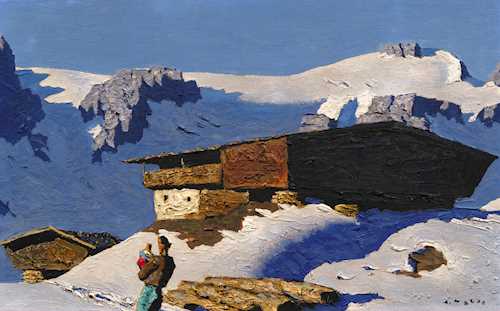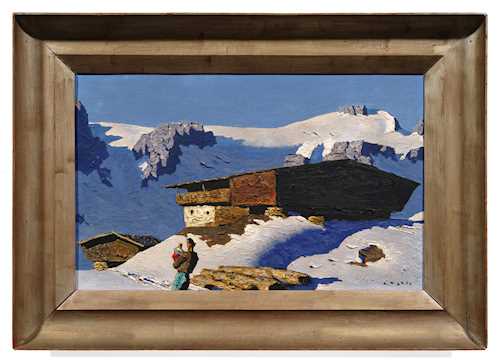
拍品 3238 - A211 印象派&现代主义 - Freitag, 29. November 2024, 05.00 PM
ALFONS WALDE
(Oberndorf 1891–1958 Kitzbühl)
Einsamer Berghof. 1934.
Oil on board.
Signed lower right: A. Walde.
Entitled and dated verso on the artist's label: "Einsamer Berghof" / 1934.
Entitled and dated verso on the artist's label: "Einsamer Berghof" / 1934.
42.4 × 67.7 cm. In original frame.
Certificate:
Provenance:
The depiction of the wintery Tyrolean mountain landscape occupies a central place in Alfons Walde’s work. The “lonely mountain farm” is an important motif during the 1930s, which is also seen in the form of a colored postcard published by the artist.
The imposing farmhouse with a brick dwelling and wooden threshing floor sits on a mountaintop. To the left below on the mountain slope is another wooden stable. In the background, the mountain range with rocky areas and snowy fields against a cloudless blue sky completes the scene.
The woman with the child in the foreground catch the viewer’s attention. This addition of one or more figures to the previously deserted winter landscapes can be observed only in Walde’s work from the 1930s onwards and suggests that it is more than just staffage. In addition to the symbolism of the link between nature and man or the religious interpretation (mother with child), a temporal biographical reference may also be suggested. Walde’s second wife gave birth to a child in 1930. It is also fitting that in this picture of a mountain farm, winter already seems to be giving way to the beginnings of spring: the season of awakening and new life. The spring sun, coming in from the left, has already licked away the snow in some places.
Stylistically, the scene is very beautiful, as the artist indicates the spring sun through strong contrasts of light and shadow. The darker blue shades of the rocks stand out from the lighter blue shades of the snowy fields. At the same time, the areas that are strongly lit by the sun are emphasized by the thick, pasty application of paint.
Both of Walde’s works (see also lot 3241) are provided with the original artist's frames with the wide champfer. This type of frame, in which several pieces are glued together and the concave fillet is visible, was designed by Walde himself from 1923-25 and used primarily for his landscapes.
The imposing farmhouse with a brick dwelling and wooden threshing floor sits on a mountaintop. To the left below on the mountain slope is another wooden stable. In the background, the mountain range with rocky areas and snowy fields against a cloudless blue sky completes the scene.
The woman with the child in the foreground catch the viewer’s attention. This addition of one or more figures to the previously deserted winter landscapes can be observed only in Walde’s work from the 1930s onwards and suggests that it is more than just staffage. In addition to the symbolism of the link between nature and man or the religious interpretation (mother with child), a temporal biographical reference may also be suggested. Walde’s second wife gave birth to a child in 1930. It is also fitting that in this picture of a mountain farm, winter already seems to be giving way to the beginnings of spring: the season of awakening and new life. The spring sun, coming in from the left, has already licked away the snow in some places.
Stylistically, the scene is very beautiful, as the artist indicates the spring sun through strong contrasts of light and shadow. The darker blue shades of the rocks stand out from the lighter blue shades of the snowy fields. At the same time, the areas that are strongly lit by the sun are emphasized by the thick, pasty application of paint.
Both of Walde’s works (see also lot 3241) are provided with the original artist's frames with the wide champfer. This type of frame, in which several pieces are glued together and the concave fillet is visible, was designed by Walde himself from 1923-25 and used primarily for his landscapes.
CHF 100 000 / 180 000 | (€ 103 090 / 185 570)


